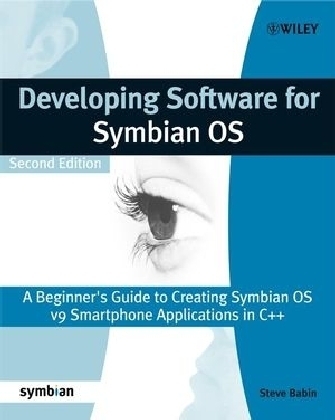
Developing Software for Symbian OS
John Wiley & Sons Ltd (Verlag)
978-0-470-72570-2 (ISBN)
- Titel ist leider vergriffen;
keine Neuauflage - Artikel merken
Many problems encountered by engineers developing code for specialized Symbian subsystems boil down to a lack of understanding of the core Symbian programming concepts. Developing Software for Symbian OS remedies this problem as it provides a comprehensive coverage of all the key concepts. Numerous examples and descriptions are also included, which focus on the concepts the author has seen developers struggle with the most. The book covers development ranging from low-level system programming to end user GUI applications. It also covers the development and packaging tools, as well as providing some detailed reference and examples for key APIs. The new edition includes a completely new chapter on platform security. The overall goal of the book is to provide introductory coverage of Symbian OS v9 and help developers with little or no knowledge of Symbian OS to develop as quickly as possible. There are few people with long Symbian development experience compared to demand, due to the rapid growth of Symbian in recent years, and developing software for new generation wireless devices requires knowledge and experience of OS concepts.
This book will use many comparisons between Symbian OS and other OSes to help in that transition. Get yourself ahead with the perfect introduction to developing software for Symbian OS.
Steve Babin works at IBM developing enterprise software for smartphones based on Symbian OS and MIcrosoft Windows Mobile. He has a BSEE from Louisiana State University and over 20 years of software development and leadership experience on a variety of products - including medical devices, Java accelerators, avionics, Internet appliances, and system-on-chip silicon devices - using numerous operating systems. Steve is married to Sharon and has a daughter named Hillary. They live in Austin, TX. He is an Accredited Symbian Developer.
Foreword (Jo Stichbury) Foreword (Warren Day) Biography. Author Acknowledgments. Symbian Press Acknowledgments. Symbian OS Code Conventions and Notations Used in the Book. 1. Smartphones and Symbian OS. 1.1 Notes on this New Edition. 1.2 Smartphone Concepts. 1.3 Smartphone Features. 1.4 The Mobile OS. 1.5 Symbian OS - A Little History. 1.6 Symbian OS Smartphones. 1.7 Other Smartphone Operating Systems. 2. Symbian OS Quick Start. 2.1 What Do You Need to Get Started? 2.2 Firing Up the Development Tools. 2.3 Simple Example Application. 2.4 Building and Executing on the Emulator. 2.5 A Carbide.c++ Project. 2.6 Building for the Smartphone. 3. Symbian OS Architecture. 3.1 Components in Symbian OS. 3.2 Multitasking in Symbian OS. 3.3 Shared Code: Libraries, DLLs, and Frameworks. 3.4 Client-Server Model. 3.5 Memory in Symbian OS. 3.6 The Kernel. 3.7 Active Objects and Asynchronous Functions. 3.8 GUI Architecture. 3.9 High-Performance Graphics. 3.10 The Communication Architecture. 3.11 Application Engines and Services. 3.12 Platform Security. 4. Symbian OS Programming Basics. 4.1 Use of C++ in Symbian OS. 4.2 Non-standard C++ Characteristics. 4.3 Basic Data Types. 4.4 Symbian OS Classes. 4.5 Exception Error Handling and Cleanup. 4.6 Libraries. 4.7 Executable Files. 4.8 Naming Conventions. 4.9 Summary. 5. Symbian OS Build Environment. 5.1 SDK Directory Structure. 5.2 Build System Overview. 5.3 Basic Build Flow. 5.4 Build Targets. 5.5 What is a UID? 5.6 The Emulator. 5.7 Building Shared Libraries. 5.8 DLL Interface Freezing. 5.9 Installing Applications on the Smartphone. 6. Strings, Buffers, and Data Collections. 6.1 Introducing the Text Console. 6.2 Descriptors for Strings and Binary Data. 6.3 The Descriptor Classes. 6.4 Descriptor Methods. 6.5 Converting Between 8-Bit and 16-Bit Descriptors. 6.6 Dynamic Buffers. 6.7 Templates in Symbian OS. 6.8 Arrays. 6.9 Other Data Collection Classes. 7. Platform Security and Symbian Signed. 7.1 What is Platform Security? 7.2 What Platform Security is Not. 7.3 What this Means to a Developer. 7.4 Capabilities for API Security. 7.5 Application Signing in Symbian. 7.6 Getting Your Application Symbian Signed. 7.7 Developer Certificates. 8. Asynchronous Functions and Active Objects. 8.1 Asynchronous Functions. 8.2 Introducing Active Objects. 8.3 The Active Scheduler. 8.4 Active Scheduler Error Handling. 8.5 Active Object Priorities. 8.6 Canceling Outstanding Requests. 8.7 Removing an Active Object. 8.8 Active Object Example. 8.9 Active Object Issues. 8.10 Using Active Objects for background Tasks. 9. Processes, Threads, and Synchronization. 9.1 Processes. 9.2 Using Threads on Symbian OS. 9.3 Sharing Memory Between Processes. 9.4 Memory Chunks. 9.5 Thread Synchronization. 10. Client-Server Framework. 10.1 Client-Server Overview. 10.2 A Look at the Client-Server Classes. 10.3 Client-Server Example. 11. Symbian OS TCP/IP Network Programming. 11.1 Introduction to TCP/IP. 11.2 Network Programming Using Sockets. 11.3 Symbian OS Socket API. 11.4 Example: Retrieving Weather Information. 11.5 Making a Network Connection. 12. GUI Application Programming. 12.1 Symbian OS User Interfaces. 12.2 Anatomy of a GUI Application. 12.3 Application Classes. 12.4 Resource Files. 12.5 Dialogs. 12.6 Symbian OS Controls. 12.7 View Architecture. 12.8 Application Icon and Caption. References. Index.
| Erscheint lt. Verlag | 19.10.2007 |
|---|---|
| Reihe/Serie | Symbian Press |
| Verlagsort | Chichester |
| Sprache | englisch |
| Maße | 189 x 235 mm |
| Gewicht | 844 g |
| Themenwelt | Mathematik / Informatik ► Informatik ► Betriebssysteme / Server |
| ISBN-10 | 0-470-72570-2 / 0470725702 |
| ISBN-13 | 978-0-470-72570-2 / 9780470725702 |
| Zustand | Neuware |
| Haben Sie eine Frage zum Produkt? |
aus dem Bereich


